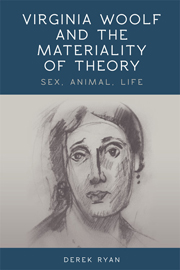Book contents
- Frontmatter
- Contents
- Acknowledgements
- Abbreviations
- Introduction: Virginia Woolf and the Materiality of Theory
- 1 Materials for Theory: Digging Granite and Chasing Rainbows
- 2 Sexual Difference in Becoming: A Room of One's Own and To the Lighthouse
- 3 Queering Orlando and Non/Human Desire
- 4 The Question of the Animal in Flush
- 5 Quantum Reality and Posthuman Life: The Waves
- Bibilography
- Index
1 - Materials for Theory: Digging Granite and Chasing Rainbows
Published online by Cambridge University Press: 05 September 2013
- Frontmatter
- Contents
- Acknowledgements
- Abbreviations
- Introduction: Virginia Woolf and the Materiality of Theory
- 1 Materials for Theory: Digging Granite and Chasing Rainbows
- 2 Sexual Difference in Becoming: A Room of One's Own and To the Lighthouse
- 3 Queering Orlando and Non/Human Desire
- 4 The Question of the Animal in Flush
- 5 Quantum Reality and Posthuman Life: The Waves
- Bibilography
- Index
Summary
If we think of truth as something of granite-like solidity and of personality as something of rainbow-like intangibility and reflect that the aim of biography is to weld these two into one seamless whole, we shall admit that the problem is a stiff one. (E4 473)
Perhaps her most famous figuration taken from the natural world, Virginia Woolf's ‘granite and rainbow’ (E4 478) is the centrepiece of a theory which appears to capture both halves of a ‘neatly split up’ question concerning the aims of biography. Her 1927 essay ‘The New Biography’ assimilates granite with the ‘hard facts’ of reality: it is ‘truth in its hardest, most obdurate form; it is truth as truth is to be found in the British Museum’ (E4 473). In Woolf's view this is characteristic of Sir Sidney Lee's A Life of William Shakespeare (1898) and King Edward VII: A Biography (1925), books which are ‘dull’ and ‘unreadable’ respectively, and which, typical of Victorian biographies, are ‘stuffed with truth’ but not ‘those truths which transmit personality’. In contrast, the rainbow is assimilated with the ‘artful or highly coloured’ which ‘consists in personality’, and Woolf provides the earlier example of James Boswell's The Life of Samuel Johnson LL.D (1791), arguing that upon reading it ‘we are aware that there is an incalculable presence among us which will go on ringing and reverberating in widening circles however times may change and ourselves’.
Information
- Type
- Chapter
- Information
- Virginia Woolf and the Materiality of TheorySex, Animal, Life, pp. 26 - 57Publisher: Edinburgh University PressPrint publication year: 2013
